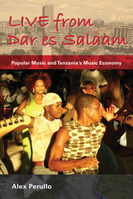PURL 5.6 | Performance: Hamza Kalala, interview and performance, “Kitimoto” (Pork) Part 2
About this recording
In this second take, Kalala sings the entire opening of the song. In live concerts, this opening would be followed by another segment called a sebene in Lingala or chemko in Swahili, which is the longer, more danceable portion of a song. Without a full band or an audience of people wanting to dance, however, Kalala has no reason to perform this section.
The opening line of "Kitimoto" is sung in Kinyamwezi and describes a conversation between two slaves in colonial times. One slave, Hussein, receives a pass to return to his family. The other slave says goodbye to Hussein, telling him to greet everyone for him and tell them all is well.
Kalala switches to Swahili for the second part of the song. Here the lyrics deal with practices or occurrences that would shock people living in a rural village.
Hamza Kalala
"Kitimoto"
Toka lini ngozi ya kitimoto ikawamba ngoma
Kama si miujizi [ni] nini?
Yele, yele, yele*
Toka lini ngoma ya watoto ikakesha
Kama si maajabu [ni] nini?
Yele, yele, yele*
Ndiyo maana nyimbo zote za watoto zinafanaa
Kama si majabu [ni] nini?
Yele, yele, yele*
Hamza Kalala
"Pork"
Since when has pig skin been used to make ngoma drums
If that's not surprising what is?
Yele, yele, yele*
Since when has children's ngoma kept people awake at night
If that's not strange what is?
Yele, yele, yele*
This is why all children's songs resemble each other
If that's not strange what is?
Yele, yele, yele*
"Yele, yele, yele" is sometimes used in Congolese influenced music to mean cry or to show disbelief. I never asked Kalala how he was using it here. Other international artists also use this expression. See, for instance, Wyclef Jean's "Yele."
Guitar Playing: With just a drum for accompaniment, Kalala adds in a guitar break into the song. The break separates the previous vocal section with the one that follows, and gives a brief glimpse into an important skill in solo Tanzanian guitar playing: maintaining rhythmic feel while providing a lead melody line.
Filming: Word has spread quickly throughout the neighborhood that something is happening at Kalala's home. About twenty children gather behind the videographer and look into the video camera's LCD screen. When the children make too much noise, Kalala stops playing until they quiet down. You will notice many times throughout this performance subtle shakes, even though the camera was sitting on a tripod during the filming. The shaking is a result of children jostling for position to see Kalala's face on the LCD screen.
For other videos from this event, see PURLs 2.3, 5.5, and A.2.

 or
or






